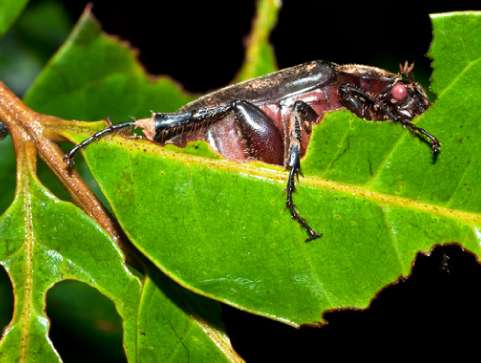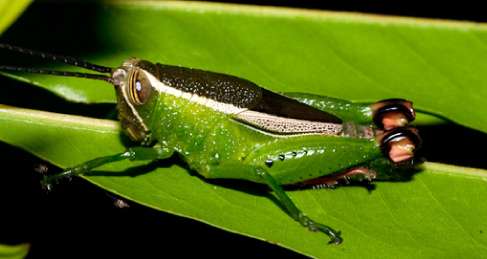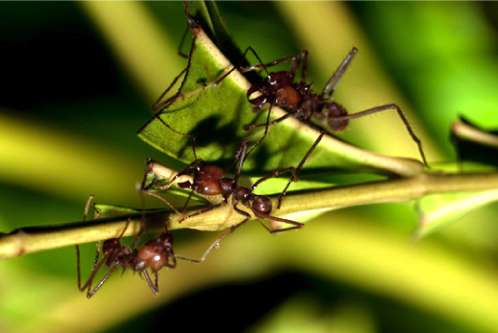Leaf chewing links insect diversity in modern and ancient forests

Observations of insects and their feeding marks on leaves in modern forests confirm indications from fossil leaf deposits that the diversity of chewing damage relates directly to diversity of the insect population that created it, according to an international team of researchers.
"The direct link between richness of leaf-chewing insects and their feeding damage across host plants in two tropical forests validates the underlying assumptions of many paleobiological studies that rely on damage-type richness as a means to infer changes in relative herbivore richness through time," the researchers report in today's (May 2) issue of PLOS ONE.
Studies of leaf chewing include observation of the leaves, but rarely include all the insects that actually made the marks. Mónica R. Carvalho, graduate student, Cornell University and Peter Wilf, professor of geosciences, Penn State, and colleagues looked at leaf predation in two tropical forests in Panama to test for a relationship between the richness of leaf-chewing insects and the leaf damage that the same insects induce.
Using Smithsonian Tropical Research Institute canopy-access cranes and working in the dark at almost 200 feet high in the treetops at new moon during two summers the researchers collected a total of 276 adult and immature leaf-chewing insects of 156 species. While the largest category of insect was beetles, leaf chewers among grasshoppers, stick insects and caterpillars, as well as a few ants, were also collected.

The team also collected fresh leaves of the insects' host plants and placed the insects in feeding experiment bags with these leaves. They allowed adult insects to feed for two to three days and immature stages to feed until full maturity when possible. The researchers then classified the damage to the leaves into categories, in the same way they catalog fossil leaf- chewing damage.
"This is the first attempt to compare leaf-chewing damage inflicted by many kinds of living insects on many kinds of plants throughout a large forest area, both to the culprit insects and to the leaf damage we see in the fossil record," said Carvalho. "We mounted 276 of the insects with their damaged leaves and deposited them in the STRI Insect Collection."
This collection is the only known vouchered collection of diverse, identified insects and their feeding damage on leaves of identified plant hosts.
The number of collected insect species correlated strongly with the number of damage types recorded in canopy leaves of 24 tree and liana species observed in the feeding experiments. This suggests that the number of types of damage seen in the fossil record is also related to the actual diversity of damage-making insects.

The researchers also compared the modern leaf data to fossil data from Colombia, Argentina, the Great Plains and the Rocky Mountains. They found that the distribution of chewing marks was the same across both modern and ancient settings, showing a striking consistency in how insects have divided up their leaf resources since at least the end of the age of dinosaurs.
"In the fossil record we frequently find a decrease in damage-type richness during cooling events and after extinctions and an increase in damage-type richness during warming events and post-extinction recovery," said Wilf. "Usually, insect body-fossils from these critical time intervals are absent or very rare, so we rely on the insect-damaged leaves to tell the story. These fossil studies have been considered tremendously important for understanding how ecosystems have responded, and will respond, to climate change and disturbance. We now have direct observational evidence that the fossil data represent changes in actual insect richness and no longer need to infer this through deduction alone."
"This work also unlocks the potential to use insect damage as a new way to assess living insect richness, as in the fossil record, in the context of climate change," said Carvalho. "We used fossils to frame a hypothesis about how the world works, today and through time, and discovered in the living tropical rainforest that the hypothesis is correct. More kinds of chewing marks means more kinds of insects."
Journal information: PLoS ONE
Provided by Pennsylvania State University




















